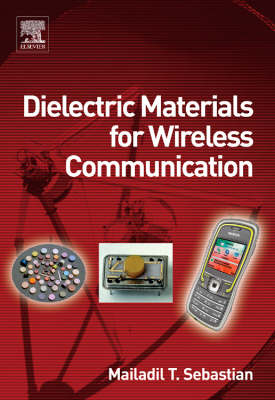
Dielectric Materials for Wireless Communication
Elsevier Science Ltd (Verlag)
978-0-08-045330-9 (ISBN)
Microwave dielectric materials play a key role in our global society with a wide range of applications, from terrestrial and satellite communication including software radio, GPS, and DBS TV to environmental monitoring via satellite.
A small ceramic component made from a dielectric material is fundamental to the operation of filters and oscillators in several microwave systems. In microwave communications, dielectric resonator filters are used to discriminate between wanted and unwanted signal frequencies in the transmitted and received signal. When the wanted frequency is extracted and detected, it is necessary to maintain a strong signal. For clarity it is also critical that the wanted signal frequencies are not affected by seasonal temperature changes. In order to meet the specifications of current and future systems, improved or new microwave components based on dedicated dielectric materials and new designs are required. The recent progress in microwave telecommunication, satellite broadcasting and intelligent transport systems (ITS) has resulted in an increased demand for Dielectric Resonators (DRs). With the recent revolution in mobile phone and satellite communication systems using microwaves as the propagation media, the research and development in the field of device miniaturization has been a major challenge in contemporary Materials Science. In a mobile phone communication, the message is sent from a phone to the nearest base station, and then on via a series of base stations to the other phone. At the heart of each base station is the combiner/filter unit which has the job of receiving the messages, keeping them separate, amplifying the signals and sending then onto the next base station. For such a microwave circuit to work, part of it needs to resonate at the specific working frequency. The frequency determining component (resonator) used in such a high frequency device must satisfy certain criteria. The three important characteristics required for a dielectric resonator are (a) a high dielectric constant which facilitates miniaturization (b) a high quality factor (Qxf) which improves the signal-to-noise ratio, (c) a low temperature coefficient of the resonant frequency which determines the stability of the transmitted frequency.
During the past 25 years scientists the world over have developed a large number of new materials (about 3000) or improved the properties of known materials. About 5000 papers have been published and more than 1000 patents filed in the area of dielectric resonators and related technologies. This book brings the data and science of these several useful materials together, which will be of immense benefit to researchers and engineers the world over. The topics covered in the book includes factors affecting the dielectric properties, measurement of dielectric properties, important low loss dielectric material systems such as perovskites, tungsten bronze type materials, materials in BaO-TiO2 system, (Zr,Sn)TiO4, alumina, rutile, AnBn-1O3n type materials, LTCC, ceramic-polymer composites etc. The book also has a data table listing all reported low loss dielectric materials with properties and references arranged in the order of increasing dielectric constant.
Dr. M T Sebastian is currently Deputy Director, National Institute for Interdisciplinary Science and Technology at Trivandrum in India. He obtained his Ph.D. in Physics from Banaras Hindu University in 1983. He taught physics at Cochin University of Science & Technology during 1984-87. He was an Alexander Von Humboldt Fellow in Germany and Nokia Visiting Fellow in Finland. He has done extensive researches in USA, UK, France, Germany, Australia, Czech Republic, Australia, Japan and Finland. He has co-authored the book “Random non-random and periodic faulting in crystals published by Gordon & Breach Science publishers (1994). He has published more than 160 research papers in international refereed journals and possesses several patents. His research interests are microwave ceramic dielectric resonators, perovskites electrode materials, crystal growth and defect characterization, X-ray scattering from disordered structures, electronic packaging materials.
Foreword by Prof. Neil Alford, F R Eng. Imperial College London
1. Introduction
2. Measurement of microwave dielectric properties and factors affecting them
3. Microwave dielectric materials in the BaO-TiO2 system
4. (Zr,Sn)TiO4 ceramics
5. Tungsten bronze type materials
6. ABO3 type perovskites
7. A(B’1/2B1/2)O3 complex perovskites
8. A(B’1/3B2/3)O3 complex perovskites
9. Cation deficient perovskites
10. A(A1/4B2/4C1/4)O3 (A=Ca,Mg, Zn, Sr, Co.., B=Nb,Ta) type materials
11. Alumina, titania and other materials
12. Low Temperature Cofired Ceramics (LTCC)
13. Tailoring the properties of low loss dielectrics
14. Conclusion
| Erscheint lt. Verlag | 23.6.2008 |
|---|---|
| Verlagsort | Oxford |
| Sprache | englisch |
| Gewicht | 1410 g |
| Themenwelt | Technik ► Elektrotechnik / Energietechnik |
| Technik ► Maschinenbau | |
| Technik ► Nachrichtentechnik | |
| ISBN-10 | 0-08-045330-9 / 0080453309 |
| ISBN-13 | 978-0-08-045330-9 / 9780080453309 |
| Zustand | Neuware |
| Haben Sie eine Frage zum Produkt? |
aus dem Bereich


